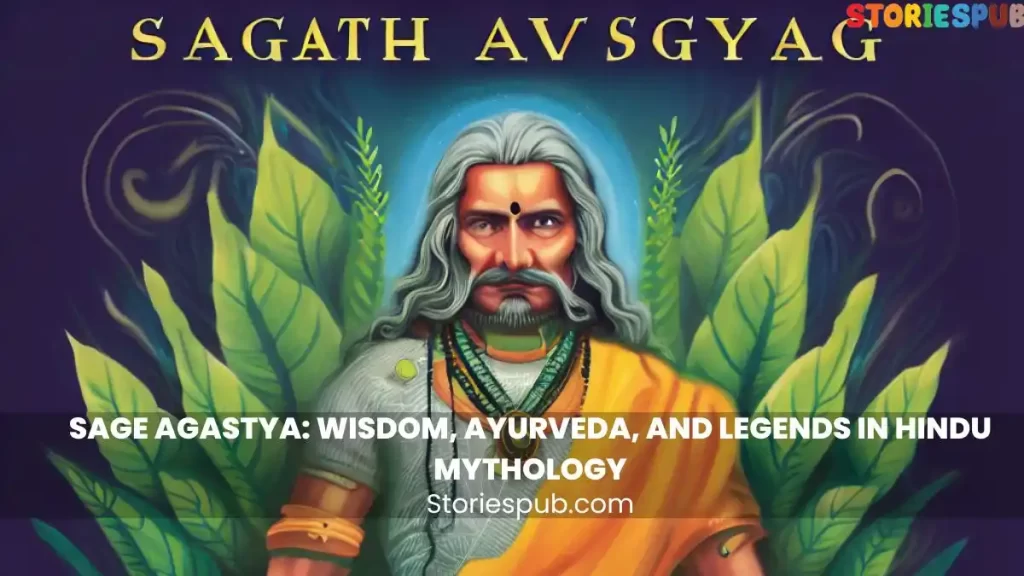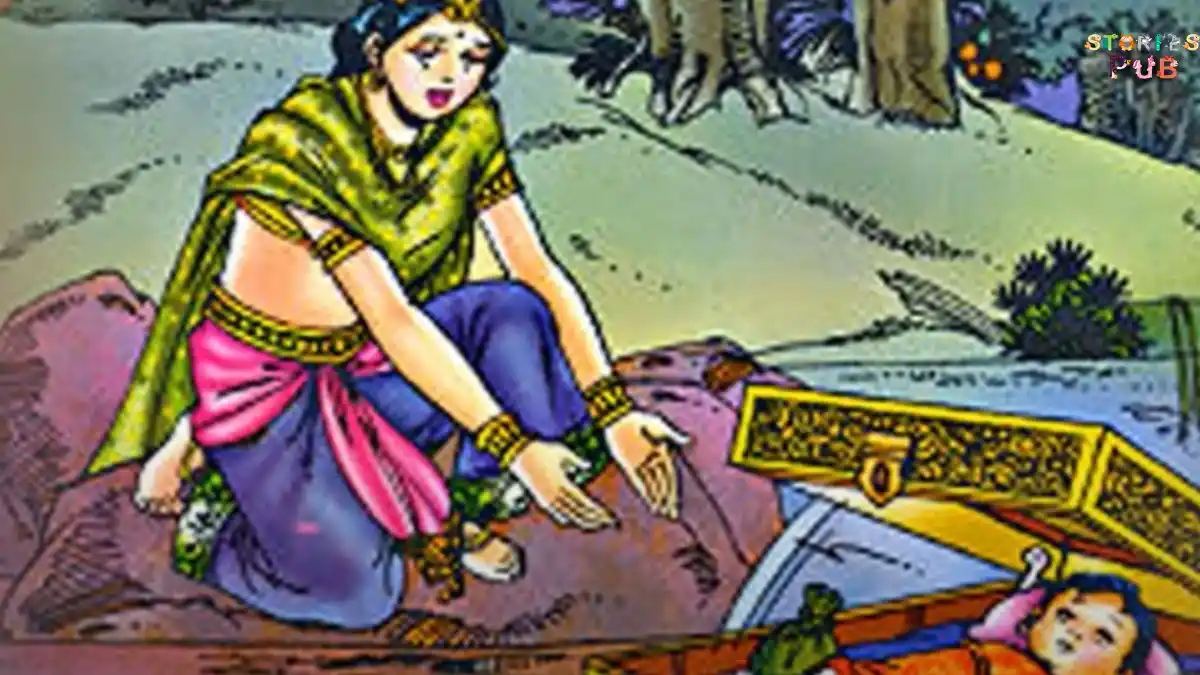Summarize this Article with:
Sage Agastya: Wisdom, Ayurveda, and Legends in Hindu Mythology

Sage Agastya is a revered figure in Indian mythology, known for his immense wisdom, knowledge of medicine, and contributions to the fields of Ayurveda and astronomy. He is considered to be one of the Saptarishis, or seven sages, and is revered as a great scholar, teacher, and sage. He is also known for his travels across India, where he is said to have spread his knowledge and teachings. Sage Agastya is a popular figure in Hinduism, and his life and teachings continue to inspire people to this day.
Who was Sage Agastya
Sage Agastya is considered one of the most revered figures in Indian mythology. His contributions to various fields of knowledge, including Ayurveda and astronomy, have had a profound impact on Indian culture and society. According to Hindu mythology, Sage Agastya was born as the son of Pulastya Rishi and the celestial nymph, Anjana. This gave him divine qualities, which contributed to his extraordinary wisdom and knowledge.
Sage Agastya’s father, Pulastya Rishi, was a great scholar and a sage. He was one of the ten Prajapatis, or mind-born sons, of Lord Brahma, the creator of the universe. As a result, Sage Agastya received his early education from his father, who taught him the Vedas, Upanishads, and other important texts. This laid the foundation for Sage Agastya’s lifelong quest for knowledge and learning.
In addition to his father, Sage Agastya studied under several other prominent sages of his time. These included Angiras, Markandeya, and Bharadwaja, among others. These sages were renowned for their knowledge in various subjects, and studying under them helped Sage Agastya to become a well-rounded scholar.
Sage Agastya was known for his inquisitive mind and his thirst for knowledge. As a young man, he traveled across India in search of knowledge, visiting many different places and learning from other sages. One of the most significant places he visited was the Himalayas, where he meditated and acquired knowledge from other sages.
Sage Agastya’s contributions to Ayurveda, the traditional Indian system of medicine, are particularly noteworthy. He is believed to have played a significant role in spreading the knowledge of Ayurveda across the country. He wrote several texts on Ayurveda, including the Agastya Samhita, which is considered one of the foundational texts of Ayurveda.
In addition to his contributions to Ayurveda, Sage Agastya was also a renowned astronomer. He is believed to have made several important discoveries in the field of astronomy, including the identification of certain stars and constellations.
Sage Agastya’s teachings and wisdom continue to inspire people to this day. He is known for his famous quotes and teachings, which provide insight into the nature of the universe and the human condition. His teachings are particularly relevant in modern times, as people continue to search for meaning and purpose in their lives.
Overall, Sage Agastya was a remarkable figure in Indian mythology. His wisdom, knowledge, and contributions to various fields continue to have a profound impact on Indian culture and society. His teachings and writings continue to inspire people to this day, and his legacy serves as a reminder of the power of learning, knowledge, and wisdom.
Stories associated with Sage Agastya
Sage Agastya is a revered figure in Indian mythology and is associated with several legends and stories that have been passed down through generations. These legends and stories offer insights into his character, teachings, and contributions to Indian culture. Here are some of the most popular legends associated with Sage Agastya:
Agastya and the Vindhyas:
The legend of Agastya and the Vindhyas is one of the most popular stories associated with Sage Agastya. According to the legend, the Vindhyas, a range of mountains in central India, were growing so tall that they were blocking the path of the sun, preventing it from shining on the southern part of the country. This created problems for the people living in the southern regions, as they were unable to grow crops and faced other difficulties.
The gods, who were concerned about the situation, asked Sage Agastya for help. Sage Agastya was known for his wisdom and his ability to solve problems, and the gods believed that he could find a solution to the problem.
Sage Agastya agreed to help and set out to the Vindhyas. When he arrived, the mountains greeted him with great respect and humility. The Vindhyas recognized Sage Agastya’s knowledge and wisdom and asked him to help them overcome their problem.
Sage Agastya was moved by the humility of the Vindhyas and decided to help them. He asked the mountains to bow down so that the sun could shine on the southern regions of India. The Vindhyas, who were eager to help, immediately complied with Sage Agastya’s request and bowed down. Sage Agastya then stepped onto their back and stayed there, becoming a part of the Vindhyas.
The Vindhyas never grew tall again, and the sun was able to shine on the southern regions of India. The people in the region were grateful to Sage Agastya for his help, and the legend of his ability to solve problems with wisdom and diplomacy became popular.
The story of Agastya and the Vindhyas is often cited as an example of Sage Agastya’s humility and his ability to solve problems with wisdom and diplomacy. It also reflects the close relationship between humans and nature in Indian mythology, where mountains and other natural elements are believed to have a consciousness and can communicate with humans. The legend serves as a reminder of the power of humility, cooperation, and respect in solving problems and achieving common goals.
Agastya and Lopamudra:
The story of Agastya and Lopamudra is a popular legend associated with Sage Agastya. According to the legend, Lopamudra was a princess who was enamored by the wisdom and knowledge of Sage Agastya. She approached him with the proposal of marriage, but he refused, stating that he was a hermit and could not marry.
However, Sage Agastya agreed to marry Lopamudra if she could prove that she was worthy of him. Lopamudra, who was determined to be with him, spent several years in meditation and austerity until she gained the wisdom and knowledge necessary to become Sage Agastya’s wife.
The story is often cited as an example of Sage Agastya’s strict adherence to the principles of dharma, or righteousness, and his high standards for himself and others. It also highlights the importance of self-improvement and personal growth in Indian mythology, where individuals are expected to work hard to attain their goals and overcome obstacles.
In the legend, Lopamudra’s dedication and hard work impressed Sage Agastya, and he recognized her as a worthy partner. The story also reflects the deep respect and reverence for women in Indian mythology, where women are seen as equal partners in spiritual and intellectual pursuits.
Overall, the story of Agastya and Lopamudra is a beautiful tale of love, devotion, and personal growth. It showcases the importance of adherence to dharma and the power of hard work and dedication in achieving one’s goals. It is a testament to the values and principles that are central to Indian culture and mythology.
Agastya and the demon Vatapi:
According to the legend, the demon Vatapi had the ability to take the form of a goat and was terrorizing the people of a village. The villagers were unable to defeat the demon and called upon Sage Agastya for help.
Sage Agastya, who was known for his wisdom and his ability to protect people from evil forces, accepted the challenge. When Vatapi appeared in the form of a goat, Sage Agastya ate him whole. However, Vatapi had a trick up his sleeve – he had the ability to reassemble himself inside the stomach of his victim.
But Sage Agastya was not one to be fooled. He recited a powerful mantra that prevented Vatapi from reassembling inside his stomach. When Vatapi tried to reassemble, he was unable to do so, and Sage Agastya killed him. The demon was vanquished, and the people of the village were finally free from his terror.
The story of Agastya and the demon Vatapi is often cited as an example of Sage Agastya’s bravery and his ability to protect people from evil forces. It also highlights the importance of knowledge and wisdom in overcoming obstacles and defeating evil.
In the story, Sage Agastya’s knowledge of the mantra helped him to defeat the demon, showcasing the importance of spiritual and intellectual prowess in Indian mythology. The legend also reflects the deep-seated belief in the power of good over evil and the role of sages and holy men in protecting people from evil forces.
Overall, the story of Agastya and the demon Vatapi is a powerful tale of bravery, wisdom, and protection. It serves as a reminder of the values and principles that are central to Indian mythology, and the importance of knowledge and spirituality in overcoming evil forces.
Agastya and the Churning of the Ocean:
According to the legend, the gods and demons decided to churn the ocean in order to obtain the nectar of immortality. During the churning, many things emerged from the ocean, including the poison halahala. This poison threatened to destroy the world, and the gods and demons were at a loss about how to handle it.
It was then that they turned to Sage Agastya for help. Sage Agastya was known for his wisdom and his ability to solve problems, and the gods and demons believed that he would be able to help them find a solution to the problem.
Sage Agastya realized the gravity of the situation and knew that he had to act quickly to save the world. Without hesitation, he drank the poison, thus saving the world from destruction. The poison was so potent that it turned Sage Agastya’s complexion dark, and he became known as ‘Kali Kambal’ or the one with the dark blanket.
The story of Agastya and the churning of the ocean is often cited as an example of Sage Agastya’s selflessness and his willingness to sacrifice himself for the greater good. It showcases his bravery and his devotion to protecting the world from evil forces.
The legend also highlights the deep-seated belief in the power of self-sacrifice and the importance of putting the greater good above one’s personal desires. Sage Agastya’s act of drinking the poison is seen as an act of great courage and is celebrated to this day in Hindu mythology.
Overall, the story of Agastya and the churning of the ocean is a powerful tale of selflessness, sacrifice, and devotion. It reflects the values and principles that are central to Indian culture and mythology and serves as an inspiration for people to work towards the greater good of society.
Agastya and the King Harishchandra:
King Harishchandra was a just and righteous ruler who had fallen on hard times. He had lost his wealth, kingdom, and even his family due to a series of misfortunes.
Sage Agastya came to know about the king’s plight and decided to help him. He performed a yagna or sacrifice that restored the king’s prosperity and fortunes. King Harishchandra was deeply grateful to Sage Agastya for his help and offered to give him a gift in return.
Sage Agastya refused the king’s offer, stating that he did not accept anything for himself. The king was puzzled by Sage Agastya’s response and asked him why he did not want to accept the gift. Sage Agastya replied that he did not seek personal gain and that his focus was on the greater good.
The king then asked Sage Agastya to accept something for the welfare of the people. Sage Agastya asked for a piece of land where he could establish an ashram, a place where people could come to seek knowledge and enlightenment. The king readily agreed and gave Sage Agastya the land he requested.
The story of Agastya and King Harishchandra is often cited as an example of Sage Agastya’s commitment to the welfare of the people and his focus on the greater good. It reflects the importance of selflessness and devotion to the greater good in Indian mythology.
The legend also highlights the deep respect and reverence for sages and holy men in Indian culture, where they are seen as sources of wisdom and knowledge. The establishment of the ashram by Sage Agastya symbolizes the importance of knowledge and learning in Indian culture and mythology.
Overall, the story of Agastya and King Harishchandra is a beautiful tale of selflessness, devotion, and the importance of the greater good. It serves as an inspiration for people to work towards the welfare of society and to seek knowledge and enlightenment.
Agastya and the Demon Ilvala:
Sage Agastya was traveling through a forest when he was captured by the demon Ilvala, who intended to cook him for his brother, Vatapi, to eat.
Despite the danger, Sage Agastya was not afraid and, using his powers, he neutralized the powers of the demon and made him surrender. Sage Agastya then asked the demon to release him and to change his ways.
Ilvala, who was impressed by Sage Agastya’s wisdom and courage, agreed to become his disciple and learn the path of righteousness. He renounced his evil ways and began to follow the teachings of the sage. Sage Agastya, in turn, imparted his knowledge to the demon and helped him to become a better person.
The story of Agastya and the demon Ilvala is often cited as an example of Sage Agastya’s compassion and his ability to transform even the most wicked people. It reflects the deep-seated belief in the transformative power of knowledge and wisdom in Indian mythology.
The legend also highlights the importance of forgiveness and redemption, where even the most evil of people can be transformed if they are willing to seek the path of righteousness. It is a reminder of the importance of living a virtuous and righteous life and the transformative power of knowledge and wisdom.
Overall, the story of Agastya and the demon Ilvala is a powerful tale of transformation, compassion, and redemption. It serves as an inspiration for people to seek the path of righteousness and to transform their lives for the better.
Agastya and the Devi:
The goddess Devi once appeared before Sage Agastya and asked him to create a mantra that would help people achieve their goals.
Sage Agastya was known for his spiritual and creative powers, and he accepted the goddess’s request. He meditated for a long time and eventually came up with the Gayatri Mantra, which is one of the most famous and powerful mantras in Hinduism.
The Gayatri Mantra is a hymn addressed to the Sun God and is believed to have the power to bestow wisdom, knowledge, and spiritual enlightenment on those who chant it with devotion. It is one of the most widely recited mantras in Hinduism and is considered a fundamental part of daily spiritual practice.
The legend of Agastya and the Devi is often cited as an example of Sage Agastya’s spiritual and creative powers. It reflects the deep-seated belief in the power of mantras and hymns in Indian mythology and the importance of spiritual practice in daily life.
The Gayatri Mantra, which was created by Sage Agastya, has been a source of inspiration and spiritual awakening for millions of people over the centuries. It is a reminder of the transformative power of spiritual practice and the importance of seeking knowledge and enlightenment.
Overall, the story of Agastya and the Devi is a powerful tale of spiritual awakening and creative powers. It serves as an inspiration for people to seek the path of spirituality and to explore the power of mantras and hymns in their daily lives.
Agastya and the Sage Vasishtha:
Sage Agastya was traveling through the forest when he encountered the sage Vasishtha, who was meditating. Sage Agastya approached the sage and asked him to teach him a mantra that would help him in his spiritual practices.
However, the sage Vasishtha refused, saying that he only taught his mantra to his own disciples. Despite this, Sage Agastya persisted, but the sage continued to refuse. Eventually, Sage Agastya used his spiritual powers to create a new mantra, which he offered to the sage Vasishtha.
The sage was impressed by the mantra and recognized Sage Agastya’s spiritual powers. He then realized that Sage Agastya was not an ordinary person but was, in fact, a great sage himself.
The story of Agastya and the Sage Vasishtha is often cited as an example of Sage Agastya’s spiritual powers and his determination to learn and grow. It reflects the importance of spiritual practice and the transformative power of mantras and hymns in Indian mythology.
The legend also highlights the deep respect and reverence for sages and holy men in Indian culture, where they are seen as sources of wisdom and knowledge. The recognition of Sage Agastya’s spiritual powers by the sage Vasishtha emphasizes the importance of recognizing and honoring spiritual leaders and gurus.
Overall, the story of Agastya and the Sage Vasishtha is a powerful tale of spiritual growth, determination, and recognition of spiritual powers. It serves as an inspiration for people to seek the path of spirituality and to honor the wisdom and knowledge of spiritual leaders.
Agastya and the Yaksha:
According to the story, Sage Agastya was traveling through a forest when he encountered a yaksha, a type of nature spirit. The yaksha challenged the sage to answer a series of riddles.
Sage Agastya, known for his wisdom and knowledge, was able to answer the riddles correctly. Impressed by the sage’s knowledge and intelligence, the yaksha offered to grant him a boon. Sage Agastya asked for the knowledge of the Vedas and the Puranas, which are important religious texts in Hinduism.
The yaksha was pleased with Sage Agastya’s request and granted him the knowledge he desired. Sage Agastya was then able to learn and understand the Vedas and the Puranas, which are considered the foundation of Hindu philosophy and religion.
The story of Agastya and the Yaksha is often cited as an example of Sage Agastya’s deep knowledge and understanding of the religious texts of Hinduism. It reflects the importance of knowledge and learning in Indian mythology and the deep reverence for the Vedas and the Puranas.
The legend also highlights the importance of humility and respect for nature and its inhabitants. The yaksha, a nature spirit, was treated with respect by Sage Agastya, who answered the riddles with humility and grace.
Overall, the story of Agastya and the Yaksha is a powerful tale of knowledge, wisdom, and respect for nature. It serves as an inspiration for people to seek the path of knowledge and learning and to respect and honor the natural world.
Agastya and the King Kalmashapada:
In this story, the king Kalmashapada had committed a sin and was suffering from the guilt. He approached Sage Agastya for help, seeking a way to cleanse himself of the sin he had committed.
Sage Agastya, known for his spiritual wisdom and guidance, advised the king to perform a sacrifice that would absolve him of his sin. The king followed the sage’s advice and performed the sacrifice, which helped him to purify himself and rid himself of the guilt he was carrying.
The story of Agastya and the King Kalmashapada is often cited as an example of Sage Agastya’s role as a spiritual guide and teacher. It reflects the deep belief in the transformative power of spiritual practices and the importance of seeking guidance from sages and holy men.
The legend also highlights the importance of accepting responsibility for one’s actions and seeking to make amends for one’s mistakes. The king Kalmashapada was willing to seek help and guidance from Sage Agastya, and he followed the sage’s advice to perform the sacrifice that helped him to purify himself.
Overall, the story of Agastya and the King Kalmashapada is a powerful tale of spiritual guidance, purification, and the importance of seeking help and guidance in times of need. It serves as an inspiration for people to seek the path of spirituality and to seek the guidance of sages and holy men in their spiritual journey.
These stories provide a glimpse into the character and teachings of Sage Agastya, and offer insights into his contributions to Indian culture and mythology.
Agastya contributions to Ayurveda and medicine
Sage Agastya is considered one of the pioneers of Ayurveda, the traditional Indian system of medicine. He is believed to have contributed significantly to the development and spread of Ayurvedic medicine across India.
Sage Agastya wrote several texts on Ayurveda, including the Agastya Samhita, which is considered one of the foundational texts of Ayurveda. In these texts, he described various medicinal plants and their properties, as well as techniques for diagnosis, treatment, and prevention of diseases.
His contributions to Ayurveda also include the development of the concept of the doshas, which are the three fundamental energy types in the human body – Vata, Pitta, and Kapha. He also described the importance of maintaining a balance between these doshas for optimal health and well-being.
Sage Agastya’s knowledge of Ayurveda and medicine was not limited to theoretical concepts. He is also believed to have treated many people with various ailments and diseases during his travels across India. His expertise in Ayurvedic medicine and his ability to heal people earned him a reputation as a wise and skilled physician.
Overall, Sage Agastya’s contributions to Ayurveda and medicine have had a significant impact on the field of medicine in India and beyond. His writings and teachings on Ayurveda continue to be studied and practiced by Ayurvedic practitioners and scholars today, and his legacy lives on as a symbol of the power of traditional medicine and the importance of maintaining a healthy balance between the mind, body, and spirit.
Agastya works on astronomy and astrology
Sage Agastya is also known for his contributions to the fields of astronomy and astrology. He is believed to have written several texts on these subjects, including the Agastya Samhita and the Agastimata.
In his works on astronomy, Sage Agastya described the movements of celestial bodies such as the sun, moon, planets, and stars. He also wrote about the mathematical principles and calculations used to predict astronomical events such as eclipses and conjunctions. Some of his works on astronomy also included astrological interpretations of these events.
Sage Agastya’s works on astrology focused on the influence of celestial bodies on human life. He described various techniques for determining the positions of planets and stars at the time of a person’s birth and interpreting their influence on the person’s life and destiny. He also wrote about the relationship between planetary positions and various aspects of human life, including health, wealth, and relationships.
Overall, Sage Agastya’s contributions to astronomy and astrology were significant in their time and continue to influence these fields today. His works on these subjects have been studied and practiced for centuries, and his legacy lives on as a symbol of the power of ancient knowledge and the importance of the study of the cosmos in understanding our place in the universe.
Sage Agastya’s Teachings and Quotes
Sage Agastya is known for his wisdom and teachings on various subjects, including spirituality, morality, and practical living. Some of his most famous teachings and quotes include:
“Knowledge is the greatest wealth one can possess.”
“One should practice truth, non-violence, and self-control in order to attain spiritual enlightenment.”
“One should always speak the truth, even if it causes harm to oneself.”
“Anger and desire are the two greatest enemies of the soul. One should strive to overcome them through self-control and spiritual practice.”
“The greatest form of charity is the gift of knowledge.”
“One should always be kind and compassionate towards all living beings, for they are all part of the same divine consciousness.”
“The true purpose of life is to attain spiritual liberation and union with the divine.”
“The mind is the root cause of all suffering and bondage. One should strive to purify the mind through spiritual practice.”
“The greatest form of prayer is the practice of meditation, which allows one to attain union with the divine.”
“The pursuit of material wealth and pleasure is a trap that leads to suffering and bondage. One should focus on the pursuit of spiritual knowledge and enlightenment.”
These teachings and quotes reflect Sage Agastya’s emphasis on the importance of spiritual practice, morality, and self-control in attaining true happiness and liberation. His teachings have had a profound impact on the spiritual and philosophical traditions of India and continue to inspire people around the world today.
Sage Agastya FAQ
Who was Sage Agastya?
Sage Agastya was a revered figure in Hindu mythology, known for his wisdom, knowledge of medicine, and contributions to various fields.
What were Sage Agastya's contributions to Indian culture?
Sage Agastya made significant contributions to various fields, including Ayurveda, astrology, and astronomy. He is also credited with creating the Gayatri Mantra.
Which scriptures mention Sage Agastya?
Sage Agastya is mentioned in several ancient Hindu texts, including the Rigveda, Ramayana, and Mahabharata.
What is the significance of Sage Agastya in Hindu mythology?
Sage Agastya is considered one of the great sages of Hindu mythology, known for his wisdom, knowledge, and spiritual powers.
What is the role of Sage Agastya in Ayurveda?
Sage Agastya is considered one of the founding fathers of Ayurveda, and his contributions to the field are reflected in his writings, including the Agastya Samhita.
What are the famous quotes or teachings of Sage Agastya?
Some of Sage Agastya's famous quotes include "Knowledge is the supreme wealth," and "One who is steady in wisdom is called a sage."
What are the temples dedicated to Sage Agastya?
There are several temples dedicated to Sage Agastya across India, including the Agastya Muni Temple in Uttarakhand and the Agastya Rishi Temple in Tamil Nadu.
What are the legends associated with Sage Agastya?
There are several legends associated with Sage Agastya, including his encounter with the demon Vatapi, his travels and encounters with various deities and demons, and his contributions to various fields of knowledge.
What was Sage Agastya's background and family lineage?
According to Hindu mythology, Sage Agastya was born as the son of Pulastya Rishi, one of the ten Prajapatis or mind-born sons of Lord Brahma, and the celestial nymph, Anjana.
How did Sage Agastya attain his wisdom?
Sage Agastya attained his wisdom through years of study and meditation under various prominent sages of his time, as well as his own personal spiritual practices.
Hey kids, how much did you like The Sage Agastya: Wisdom, Ayurveda, and Legends in Hindu Mythology? Please share your view in the comment box. Also, please share this story with your friends on social media so they can also enjoy it, and for more such Hindu Mythology, , please bookmark storiespub.com.
Check out other stories that we have:
- 1. Lord Ganesha
- 2. Bhagavad Gita
- 3. Mahabharat
- 4. Tale of Jalandhar
- 5. Story of Prahlad
- 6. Rani Padmini













